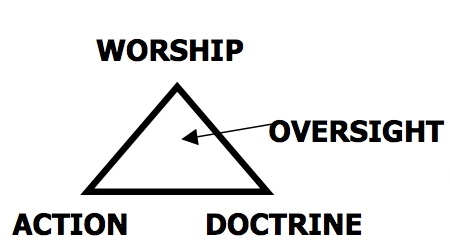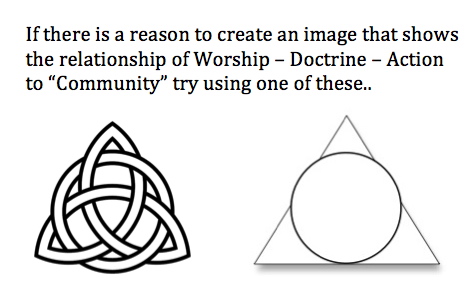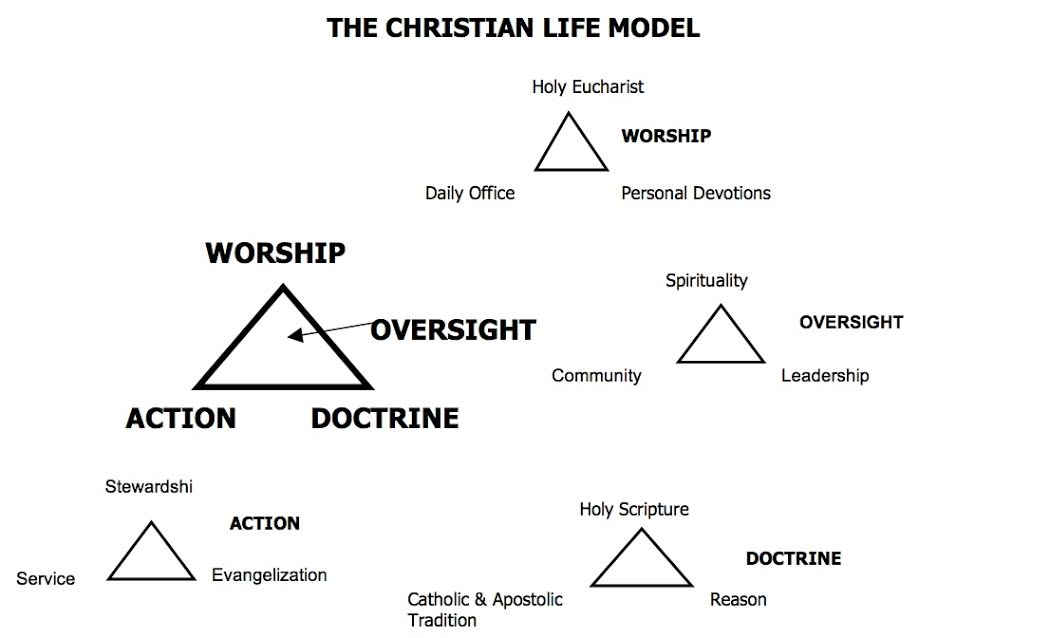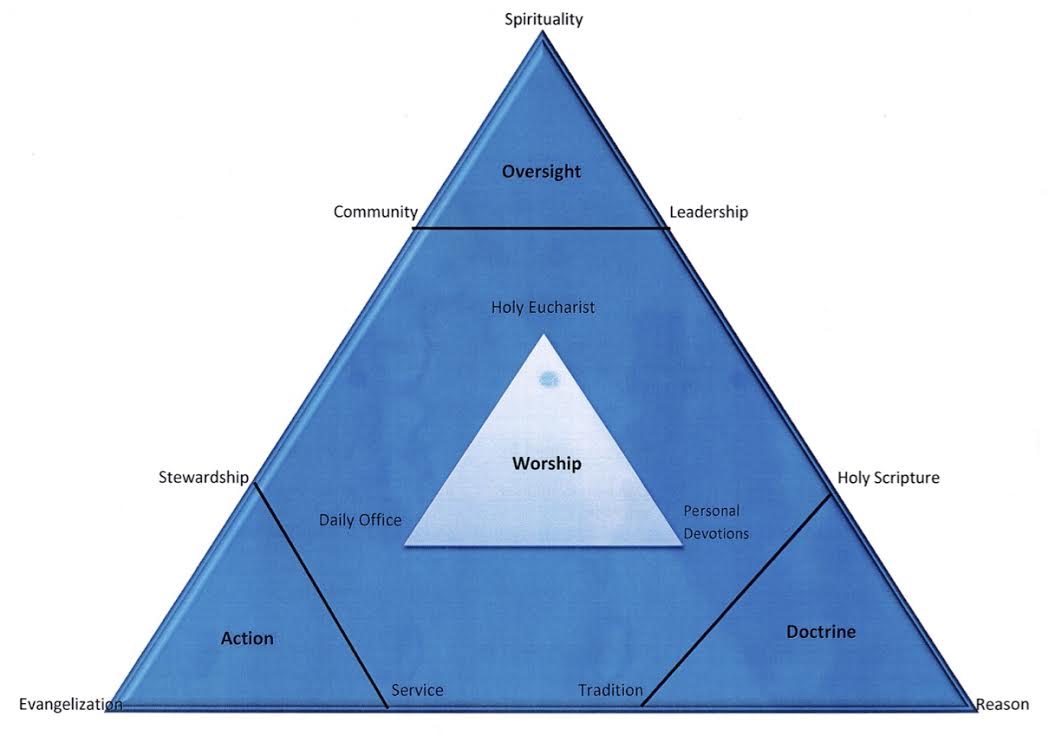I developed the Christian Life Model back in the late 1970s. It emerged for me as I read in Anglican pastoral theology and systems theory. I’ve made slight changes in wording over the years but not in the substance. It was the basis in 1982 for Power from on High: A Model for Parish Life and Development and later as a chapter in Fill All Things: The Dynamics of Spirituality in the Parish Church (2008).
It’s been widely used over the years by parish leaders and consultants in processes of exploration and planning and by spiritual directors and priests in spiritual formation ministries. Along the way a few people have tried to “improve” the model. The result has usually resulted in something that was a misunderstanding of how systems work, the spiritual dynamics involved, or simply about the process of constructing models.

A PDF of the model with a short introduction
Let me share the four most common mistakes. In each case there is something useful the person is trying to get at. Messing with the model rarely helps us get at it.
Not seeing the dynamics
There are those who use the model primarily for assessing and action planning. They approach it as categories of parish life, ask how well are we doing in each and then make plans for improvement.
All that can certainly be a way to use the model. It’s not “wrong” but in itself is often flat and limited. The model is primarily an attempt to note certain dynamics that exist in the common life of a parish church and in the life of the individual Christian. In some ways I’ve contributed to the difficulty by providing assessing instruments in the books and in a variety of training programs.
The starting place needs to be in trying to see and understand the dynamics among the elements.
Here are two mentioned in Fill All Things.
“Martin Thornton points to it in The Rock and the River and in his description offers a process and systems perspective: 'Moral action only flows from doctrinal truth by grace and faith, that is through prayer.'”
“The active relationship among Eucharist/Daily Office/Personal Devotions can be seen in how the Office is deepened and enriched by a person’s personal devotions, how all three influence one another, and how the Office and personal devotions are focused and completed in the Eucharist.”
Once we have a sense of the balancing effect of the elements in our common and individual lives, and the dynamics among them, we might make good use of the model for assessment, exploration and planning purposes.
Changing “Doctrine” to “Education” or "Formation"
In my experience this takes place in communities and individuals who are anxious about the word “doctrine.” They may associate it with being dogmatic, inflexible, and narrow-minded. That of course reverses reality.
Heresy is taking a partial truth and claiming it is the whole truth. Doctrine, especially among Anglicans, is about the complexity of reality. It is about paradox and the grand adventure of holding apparent opposites together. It is the work of creative and reality based synthesis, seeking to make of various elements a whole. It is bringing apparent opposites into a kind of unity. It is the Holy Trinity. It is Jesus Christ fully God and fully human. It is our way of diversity and unity; of the diversity of gifts brought together in harmony. Heresy is what is dogmatic, inflexible, and narrow-minded.
It is doctrine that provides us with part of the ground upon which we stand; it is doctrine that supplies the mental models that offer us spaciousness and tolerance.
Education is a method. We use that method in advancing all three primary elements of worship, doctrine and action. It can help improve what we do in relation to worship, doctrine and action.
Adding Community as a fourth element
Occasionally someone wants to add “Community” to Worship, Doctrine and Action. Making the triangle a square.
The community is the body that lives worship, doctrine and action. As Christians in our Anglican tradition that way becomes for us a path into a richer and deeper life.
Community in itself isn't constructively transformative or helpfully grounding. Nazis and the Klan were communities with their own kind of worship, doctrine and action.
There are two things you might do if you want to explicitly include “community” in a model. One is to use another model. For example, the In Your Holy Spirit model does that.
The other is that you might present the Christian Life Model as provided and then say that you would like to take note of the relationship of the model to the Christian community.
You might do this --

Do you see?
Adding experience as a fourth element in Doctrine
If you're a Methodist it's understandable. If you're an Anglican it's being confused.
Of course, in day-to-day life our experience does have authority. It certainly does for me. However, the fact that I give so much “authority” to my experience is frequently a problem. It’s obviously self-oriented. It usually takes little notice of the experience of others. It’s not accountable to anything except itself.
Over the years I’ve done a lot of consulting and training work in which what’s at issue is: How are we to understand the experience we are having? What are we to make of it? We are in conflict or we are losing members or we can’t get much participation or adequate investment or life seems shallow—what is going on here?
Well-trained consultants and trainers know that experience in itself isn’t to be given much authority. It is experience that has been submitted to a disciplined process of refection to which we give authority. It is what we learn based on that disciplined reflection that offers a possible taste of wisdom. In training consultants and parish leaders I want them to have a grasp of dozens of these models and theories so they are able to approach the experience with a wide range of tools.
Often in that disciplined reflection we use a theory or model as a lens as we try to understand. Just this past week I’ve used Type theory with a group and the Shape of the Parish Model with another group.
In our tradition the sources of authority are—Scripture, Tradition and Reason. Experience isn’t a Christian source of authority in the Anglican tradition. It is what we are seeking to understand as we use the lens of Scripture, Tradition and Reason. Those authorities, in relationship with one another, are our tools for understanding our experience as Christians.
Worship at the Center
This is an addition to the list (as of April 2016 and March 2018). I ran across this mistake in a document used to present core frameworks to a group of clergy. I first came across it in the Spring of 2015. I noticed the issues in it but I was busy with other things and set it aside. I recently came across the document again.
The worship triangle had change places with the oversight triangle.
This placed worship in the center of the model. So the central dynamic of Christian life is shifted from being Worship - Doctrine - Action (as below)

to Oversight - Doctrine - Action (as below)

The starting place for this model is what the Anglican bishops at Lambeth in 1978 spoke of as pattern of life: "This inextricable fusion of worship, of doctrine, and of action constitutes the distinctive contribution the churches of the Anglican Communion desire to make to the Universal Church of God in Jesus Christ." Martin Thornton points to it in The Rock and the River and in his description offers a process and systems perspective: "Moral action only flows from doctrinal truth by grace and faith, that is through prayer"
4. I do understand the desire to highlight the importance of worship. However, that's the work of another model. This one is about the dynamic among - Worship - Doctrine - Action. A model that does emphasize the centrality of worship is the "In Your Holy Spirit Model" from the books of the same name by Michelle Heyne and me. (Gallagher book Heyne book).
Sound pastoral theology
Sound pastoral theology begins with fact and truth. Our starting place is what’s real rather than what’s ideal or in some sense "needed."
In 1978 at Lambeth the bishops noted this “inextricable fusion of worship, of doctrine, and of action” as a particular Anglican understanding of the Christian life.
In the usual errors mentioned above what we see are either a challenge to what the bishops presented or they are a different understanding of the use of models in pastoral theology. Someone may make a case that there are more than three elements in this fusion. Others may be seeking a list of things to pay attention to rather than a map of an existing intricate relationship.
What I see in the model are elements that can’t be disentangled because they are an image that represents something that is real. The model is a complex synthesis of elements.
A useful way to engage the model—really any model. How to work with the copyrighted material
1. If you find yourself trying to highlight some element of Christian life not focused in the model, don't change the model. Find another model that serves your purpose. As noted above about using the IYHS Model to include Community.
2. Contact the original writer. Discuss your thinking. Maybe you're missing something about the model. Avoid embarrassing yourself. You might learn something. You might also enrich the field by advancing an understanding that the writer had missed. I have often felt embarrassed for the people making such rookie mistakes. Sadly they sometimes simply dig their heels in and yell louder.
3. In presenting to a group you might first provide the original model. Then suggest your critique or revision.
4. Ask permission for use. It’s a respectful thing to do. Even if it’s been broadly given it’s courteous to let the original writer know about your use. If you're really an open minded person have the writer comment on your revision.
rag+